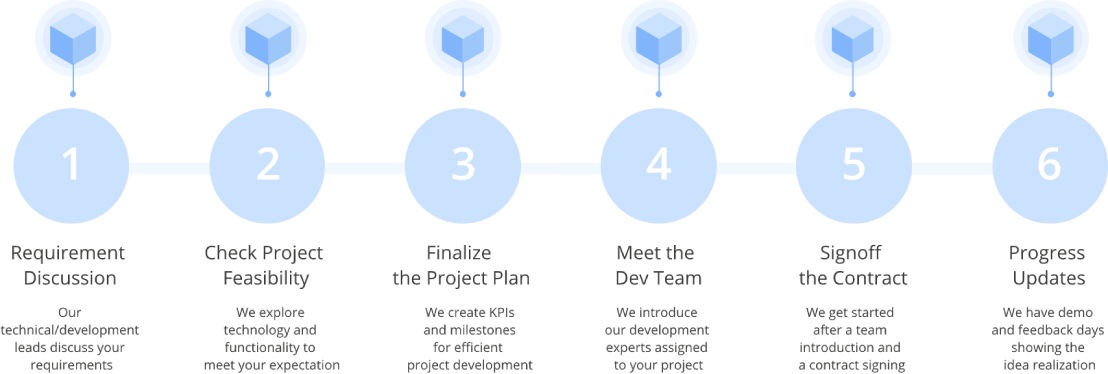-
Content producers have relied on a centralized agency to distribute their content and link it to any marketers willing to pay for associated time slots since the dawn of broadcasting, from radio to TV, cable, and streaming. The invention of the internet and the World Wide Web opened up possibilities for self-broadcasting for content creators. But they must still rely on big players to host their content and link it to marketers and consumers. We can change that with blockchain application development for decentralized streaming solutions.
Live Streaming Challenges
The downtime needs to be zero for live streaming. Thus, the first prerequisite is to develop a stable and scalable system to ensure maximum usability. It suggests that service suppliers take the same approach as conventional broadcast networks.
Also, lack of control over the entire distribution network makes live streaming prone to interruption, bad experience, and poor service quality.
Typically, content providers rely on a supplier of CDN services and pay hefty fees. But not every network provider has the same behavior or availability. It can impact your performance.
OTT sits on top of HTTP, usually referred to as technology that lets anyone view a webpage as quickly as possible. Thus, it fails to provide a protocol in real-time to cope with live streaming constraints. For this reason, a side effect of this technology is known to be latency.
Metadata refers to all the information that follows the video. It's what determines the material and provides its title, definition, volume, and much more. It may also provide information on ad breaks and other technical details required by a service like Hulu. Again, all of this backend data remain unstructured because of how modern live streaming is.Also, Read | Developing a Blockchain-Powered Media Streaming Platform
Introducing Blockchain for Live Streaming
Enhancing Data/Content security and Monetization Models
Any content creator can monetize their work somehow, either through direct payments, subscriptions, or ads. However, there are several obstacles to communicating with customers. One of them is scalability. As a result, it creates a reliance on broadcasters to distribute content and attract advertisers.
Content producers have relied on established broadcasters to create an audience that advertisers felt confident enough to address, without a way to securely collect information about audiences so that they feel able to share their data. Thus, broadcasters became gatekeepers, restricting and limiting the types of content transmission.
Blockchain enables a safe collection, authentication, and validation of data in a decentralized manner. It can offer customers more choices in terms of the type and quantity of information they are prepared to share and with whom they share it.
The technology can help content producers and marketers directly communicate with customers. It essentially bypasses aggregators and big media companies. Independent and fringe content creators can have additional possibilities to monetize their innovative work and interact directly with targeted advertisers
Also, Read | Insights into Video Streaming Platform Development with Blockchain
Applications for Inventive Advertising Models
Since blockchain technology can directly link content creators and advertisers with customers without a central authority to mediate it, data collection and exchange for viewing habits assessments can become secure. It enables marketers to offer customers more relevant content.
Also, it provides content creators a way to generate traceable revenue and prevent pirated copying with p2p business transactions. They, otherwise, have no efficient way to monetize their creative work.
A UK-based company LiveTree has launched a blockchain-based crowdfunding and distribution platform aimed at film and TV content creators. Content producers can upload their content to a streaming service similar to Netflix and track their viewership.
Consumers can determine which information they want to make accessible with a blockchain-powered solution. Consumers may, for instance, exchange information about what destinations they find interesting. It will enable marketers to target them with advertising about those destinations.
Also, Read | The Emergence of Decentralized Blockchain Video Streaming Solutions
Streamlining Licensing, Royalty Management, and Costs
Blockchain can help content creators monetize their products, not just advertising dollars. Control of rights is another area where content creators can benefit from blockchain application development.
ImageRights International uses blockchain technology to link photographs of a photographer to its US Copyright Office's registration number. It enables them to identify and demand compensation for unauthorized use. Blokur music rights management platform uses blockchain to ensure that artists get their pay promptly and equally when a third-party company uses their work.
Also, Read | Blockchain's Impact in the Media and Entertainment Industry
Simplified and Cost-effective Payment Models for Audience and Creators
Another exciting blockchain application in live streaming is to enable both the viewer and the broadcaster to take advantage of the monetization data collected.
During a broadcast, for instance, viewers can engage with the show or advertisement they are watching. Through using an app on their smart TV, phone or tablet, consumers can respond directly to the gadget they're using or whether they're watching TV.
Once signed up, audiences engage with a commercial's targeted elements and earn points. Further, with a real-world value of these points, they purchase advertised products or services.
Can Blockchain Prove to be the Ultimate Disruptor for Live Streaming Platforms
The ultimate advantage for filmmakers will be getting a decentralized broadcasting environment. It will establish a system where no single website or corporation serves as gatekeepers for content transmission.
Decentralized entertainment software, either for live-streaming or on-demand content, enables thousands of computers in a non-hierarchical mesh network to serve as broadcasters worldwide. It addresses challenges of existing cable and streaming services while providing new value-based services.
Also, Read | Blockchain's Role in Digital Content Management
Without a central gatekeeper for authorization, content becomes accessible instantly over a decentralized network. New "channels" of related content evolve organically in a decentralized distribution model. Consumers can ultimately self-discover the programs and films they want to watch. Free content services may also compete with conventional TV and internet advertisements. In return for collecting tokens, marketers can pay users to access the content. In return, it will enable them to purchase advertised goods and services at discounted rates.
A decentralized streaming network can become the next HBO or Netflix. Developing blockchain-based live streaming solutions is one of many business areas in which our blockchain development experts at Oodles excel.


Our Offices
INDIA
Emaar Digital Greens, Sector 61,
Gurugram, Haryana
122011.
Welldone Tech Park,
Sector 48, Sohna road,
Gurugram, Haryana
122018.














